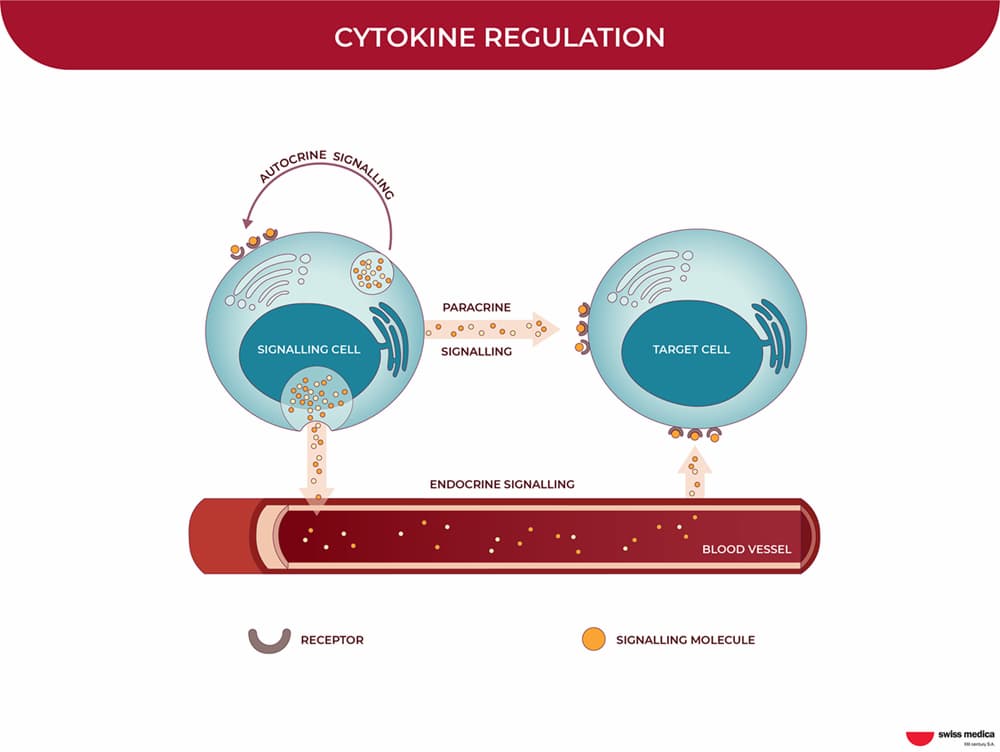The main therapeutic effect of stem cells is their ability to produce cytokines and growth factors that promote tissue regeneration and recovery.
How Does Stem Cell Therapy Work Once Stem Cells Are Introduced?
After mesenchymal stromal cells are delivered into the body, they circulate in the blood until they become attracted to proteins found around inflamed or damaged tissue. The stem cells then rush to that injured area and start producing various growth factors:
- chemokines that help cells migrate,
- adhesion molecules that regulate cell interactions at the molecular level.
Get a free online consultation
How does stem cell treatment work? To learn more about stem cell therapy firsthand from professionals, please contact us to arrange a no-obligation online consultation.

Medical Advisor, Swiss Medica doctor

Cytokines and growth factors are special molecules that help cells communicate with each other. They work by sending signals to other cells to help them heal and recover from damage. This process is called paracrine regulation. These molecules can also help stop inflammation in diseases, including autoimmune disorders.
One key aspect of these signal molecules is that their levels can change depending on how much damage there is to the tissue and the stage of healing. By using cell products based on stromal stem cells, we can boost the production of cytokines to improve the function of damaged tissue.
To learn more about the specific stem cells we use in our treatments, explore our full catalog and discover how each type supports healing and tissue repair.
See full catalogueWhat Therapeutic Effects Are Expected?
With the assistance of cell therapy, Swiss Medica offers effective treatment options that can lead to the improvement of various diseases and conditions. We work with different types of diseases of the nervous system, musculoskeletal system, heart, digestive organs, and autoimmune system, as well as issues related to age, genetic diseases, and more.
How does stem cell therapy work?
Explore 5 myths surrounding it and uncover the truth behind this innovative treatment.
How Does Stem Cell Therapy Work for Our Patients?
During our online consultations, new patients frequently ask us about the potential benefits of the treatment. It is important to note that the effects of stem cell therapy may vary across individual cases, as each patient’s response can be unique.
How does a stem cell transplant work in various conditions? Explore our detailed guide on the treatment process to discover how we tailor therapies to address different conditions.
Learn moreWe have collected some patient stories showcasing how stem cell transplants address various conditions.
5-Year-Old Patient with Autism from Israel
A patient from Israel returned to Swiss Medica for a second treatment, accompanied by his father. Following their first visit in August 2023, they were highly satisfied with the results, the clinic’s welcoming atmosphere, and the friendly staff.
After the treatment
The father noticed mild improvements in their son’s behavior within a week after the treatment. These included better understanding of speech, following instructions, dressing himself, and being more relaxed. The progress was slow but consistent. The parents hope to see further improvements in his use of words, sleep patterns, and temperament.
Patient with Ankylosing Spondylitis from Switzerland
The patient had been suffering from this progressive disorder since the age of 13. The problem started with a sacroiliac joint, affecting the sacroiliac region, the hip, and the spine. This resulted in a hunchback while walking, difficulty walking long distances, and stiffness during sleep, causing the need to wake up several times during the night and walk. He received his first treatment in October 2023 and was pleased with the results.
After the treatment
After the treatment, he noticed immediate changes that continued gradually over six months. His night patterns improved significantly, allowing him to sleep continuously for 6–7 hours. His joints became less rigid, and the junction wear was resolved. The patient returned for the second treatment, which also includes physiotherapy, in hope for even better results.
Interested in starting your own journey?
Learn more about the application process at Swiss Medica and how you can begin your path to better health.
Story of Michael Holland with Parkinson’s disease
First diagnosed in 2018, the patient from England was told that the disease might have begun in 2009. The disease influenced his life, making him need to plan his day carefully and preventing him from sitting and listening for long periods.
After the treatment
The patient returned for the fourth treatment as he felt better and refreshed, and each treatment brought noticeable benefits. He felt that the progression of Parkinson’s disease slowed down or even stopped. The first improvements appeared three months after the treatment. The patient remained satisfied with the treatment and the attitude of the doctors and fully intended to continue the treatment.
Contact us
Our medical advisors provide a no-obligation online consultation to discuss the suitability of stem cell therapy for your case and help you plan the next steps. Please fill out the form below.

Medical Advisor, Swiss Medica doctor
Continue Your Journey
Find out more with these related reads:
List of References
Lapidot T, Petit I. Current understanding of stem cell mobilization: the roles of chemokines, proteolytic enzymes, adhesion molecules, cytokines, and stromal cells. Exp Hematol. 2002 Sep;30(9):973-81. doi.org/10.1016/s0301-472x(02)00883-4
Bujak M, Frangogiannis NG. The role of IL-1 in the pathogenesis of heart disease. Arch Immunol Ther Exp (Warsz). 2009 May-Jun;57(3):165-76. doi.org/10.1007/s00005-009-0024-y